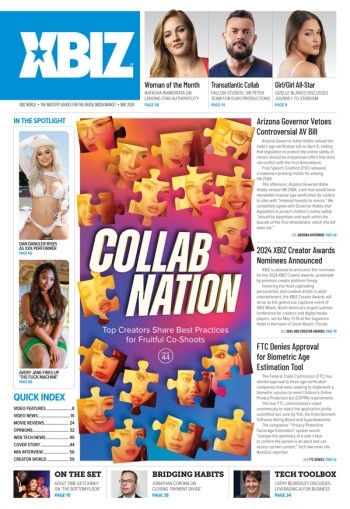If content is king in adult, then technical quality is the throne upon which it sits. Technical quality drives customer acquisition and new sales, while cementing retention and long-term loyalty.
When a new visitor lands on a site, one of the first things they are likely to notice is the quality of the content presented. High-definition (HD) videos, characterized by superior clarity, color fidelity and immersive audio, can significantly elevate the user experience, making a compelling case for committing to a subscription — while poor quality can discourage them from engaging beyond a fleeting visit.
Content that is already of low quality, heavily compressed or damaged may not benefit significantly from upscaling, and in some cases, the process may even exacerbate existing flaws.
The role of quality content in search engine optimization (SEO) and site visibility cannot be overstated either. Content that is engaging and of high quality is more likely to be shared, liked and recommended across social media and other platforms, increasing the site’s organic reach. This can lead to improved search engine rankings, driving more traffic to the site and increasing the potential for new subscriber conversions.
A reputation for technical quality serves as a beacon for a platform’s brand, symbolizing its commitment to excellence and positioning it as a leader in a crowded marketplace. It not only draws viewers, but also attracts the best content producers, who are keen to associate with platforms that reflect their own standards of excellence.
As consumer electronics evolve, so do viewer expectations for content quality. With the widespread availability of high-definition screens and devices capable of displaying 4K content, consumers increasingly expect content that leverages the full capabilities of their technology. For consumers, HD and 4K content are not just visual treats; they are the hallmarks of a premium service, justifying a higher price point.
All of these facts make it clear that platforms seeking to meet those expectations and keep their content relevant and appealing need to invest in high-quality production technology. But what about legacy content that may not be quite up to cutting-edge standards? That’s where upscaling comes in.
The Advantages of Upscaling Old Content
Upscaling offers a way to rejuvenate legacy content, transforming dated videos into vibrant, high-def experiences. This reinvigorates existing content, extending its life by making it appealing to new audiences. Upscaling can also offer longtime fans a fresh perspective on classic content, enhancing visual clarity, color depth and overall presentation to reveal hidden details and nuances in older videos. This can lead to a resurgence in interest and viewership, breathing new life into content that might otherwise remain overlooked among vast digital archives.
Upscaling allows site owners to elevate the quality of their existing content without the financial burden of new productions. This not only enhances the value of the content library but also allows platforms to respond rapidly to market demand for HD content, maximizing the utility of existing assets.
The Challenges of Upscaling Old Content
Upscaling requires a substantial initial investment in specialized technology, software and skilled personnel. This financial outlay can be daunting, particularly for smaller platforms with limited budgets. Site owners must carefully consider the cost-benefit ratio of upscaling, weighing the potential enhancements in content quality against the significant upfront costs. This calculation involves not only the direct expenses of the upscaling process but also the ancillary costs associated with training, technology upgrades and potential disruptions to content workflows.
Upscaling does not guarantee uniform improvements in quality across all content. The success of upscaling efforts can vary widely, depending on the quality of the original footage, the upscaling techniques employed and the specific characteristics of each video. This variability can lead to inconsistent viewing experiences, with some upscaled content falling short of viewer expectations.
Upscaling is not a simple process. It involves a complex interplay of technical factors, from the choice of video codecs to the management of bit rates and the preservation of original video quality. Navigating these technical waters requires expertise and a deep understanding of both the upscaling technology and the characteristics of the content being upscaled. Site owners must invest in training and technology to ensure that their teams are equipped to handle the challenges of upscaling, from selecting the right tools to optimizing the upscaling process for each piece of content.
Not every piece of content is a good candidate for upscaling. The original quality of the footage, the age of the content and the condition of the source material all play critical roles in determining the suitability of videos for upscaling. Content that is already of low quality, heavily compressed or damaged may not benefit significantly from upscaling, and in some cases, the process may even exacerbate existing flaws. Site owners must carefully assess their content libraries, selecting only videos likely to yield meaningful improvements through upscaling.
Site owners must also consider their audience’s technology profile, ensuring that their investments in content quality align with the capabilities of their viewers’ devices. The full benefits of upscaling to HD formats can only be realized on compatible viewing hardware, but not all viewers have access to devices capable of displaying 4K content. This can be a significant barrier to the widespread adoption of upscaled content, particularly in markets where high-definition viewing devices are not yet the norm.
Upscaling involves altering the original content, which can raise legal and ethical concerns, particularly regarding copyright and content ownership. Site owners must navigate these issues with care, ensuring that they have the necessary permissions and rights to modify and distribute the upscaled content. This includes securing agreements from content producers, performers and any other rights holders associated with the original footage. Failure to address these legal and ethical considerations can lead to disputes, legal challenges and damage to the platform’s reputation.
The process of upscaling is resource-intensive, requiring significant computational power and, in many cases, specialized hardware or cloud-based services. This level of demand for resources can strain a platform’s operational capabilities, particularly for smaller operators or those with limited technical infrastructure. Site owners must plan for these resource requirements, allocating budget and technology resources to support the upscaling process without compromising other aspects of their operations.
Make Your Choice and Be Dynamic
Managing viewer expectations is critical. Audiences accustomed to the pristine quality of native 4K productions may have high expectations for upscaled content, expecting similar levels of detail, color accuracy and overall visual fidelity. For reasons noted above, however, upscaled content may not always match the quality of content originally produced in HD formats. Site owners must be sure to market and present upscaled content in a way that accurately reflects its quality and the improvements made through the upscaling process.
Upscaling old content offers compelling advantages, but also presents significant challenges. Site owners must therefore carefully weigh the decision to upscale. As with most business decisions, it ultimately comes down to return on investment. My advice is to discuss the possibilities of upscaling legacy content with your IT experts, to decide if the juice is worth the squeeze.
Brad Mitchell is the founder and president of MojoHost, which has served the industry for nearly two decades and has been named XBIZ Web Host of the Year several times. He regularly shares insights as a panelist at trade shows. Contact brad@mojohost.com to learn more about the suite of services his company offers.






